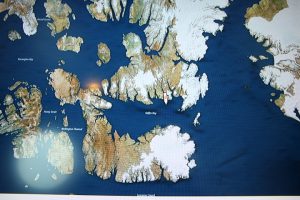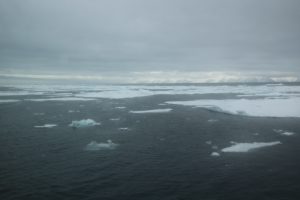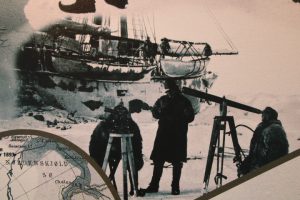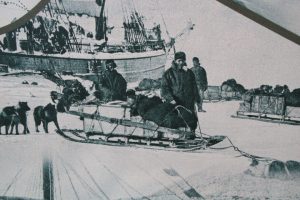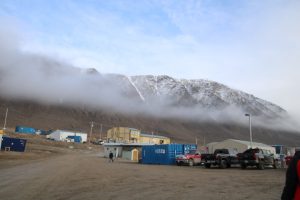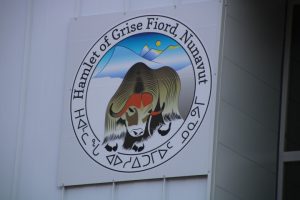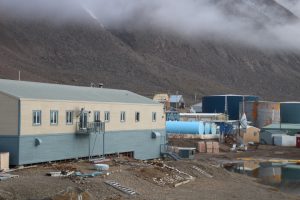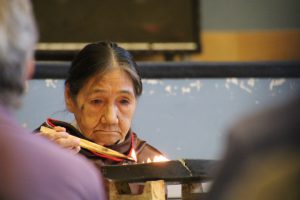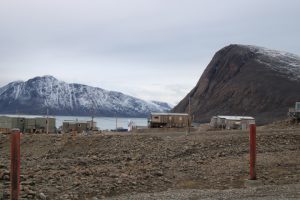This morning we are heading to Grise Fjord at 76° 25´ North, 82° 54´ West. It is known by the Inuit as Aujuittuq, ‘a place that never thaws’. It is the most northerly community in this region. There are only two other settlements on Ellesmere Island such as Eureka and Alert which has a decaying Distant Early Warning station from the Cold War.
At 5:00 a.m. in Glacier Fjord we encountered sea ice, some of it scraping along the hull of the ship and by 8:00 a.m. at a speed of 2 knots we encountered more substantial ice. We are continuing our journey with about 30 miles to go across the Lancaster Sound to reach our destination for today.
We are not on our planned course at the moment. At this time of year summer is drawing to a close and the ice begins to freeze across narrow inlets. It is this concentration of ice around our destination that has caused us to divert for today. Last evening, at the briefing, we were informed that Grise Fjord had ‘do-able ice’ and that if the ice towards Resolute and Cambridge Bay broke up even further as it has started to do we could get back more or less on track. We are hoping for a disembarkation at Resolute Bay if nothing else happens with the ice. We have to wait for the ice reports at the briefing this evening.
Grise Fjord or Pig Fjord was given its name by the Norwegian leader, Otto Sverdrup, of the second Fram expedition of 1898 when the call of the walrus reminded him of the sound of pigs.
This expedition spent four winters in the ice here having been prevented from going any further north. By 1902 when this expedition was over, the team had made these polar expedition records:
762 days in tents
18,000km of deg sled work
mapped Jones Sound
discovered 3 islands and claimed them for Norway
mapped Cornwall Island
added 250,000 sq km of new land to the blanks on existing maps
discovered more than 2000 plants and plankton
mapped Ellesmere Island
created a 5 volume scientific report with many popular books for public consumption on the back of this.
The Fram expeditions were sponsored by private companies who saw any success as a means of promoting their brand. The first Fram expedition of 1893 set a record of reaching the furthest north at 86deg 14min. The spinoff from this was the Nansen Brand on such things as Arctic Salmon and beer. Publishers even super-imposed his head on the male characters of the ancient saga stories. The second expedition was sponsored by the Ringnes Company, the largest brewery in Norway. Not only was the brewery’s name on beer but Sverdrup named two islands found after the two brothers. Today they are called Ellef Ringnes Island and Amund Ringnes Island. Sverdrup named a vast expanse of the region after himself.
The first Fram expedition had massive coverage in Norwegian newspapers and massive crowds lined the streets of Oslo when the expedition returned. The second expedition was more scientific and the general public were not as interested. This is similar to what happened during the Apollo Moon Program. The crew of Apollo 11 were heroes but when the television camera on Apollo 12 was pointed at the sun and ruined the general public were no longer interested. Returning to the Fram, all of the experiences of the first two missions were used by Amundsen on the third expedition when he successfully reached the South Pole. The general public were ‘back on board’ as thousands welcomed the team home. In the Apollo Program it was the rescue of the crew of Apollo 13 that put the public back on board.
We participated in a landing at Grise Fjord. Walking up the rocky beach it was obvious that we were in a very special and challenging location. The steep beach was topped with the remains of sea ice and the village was surrounded by high, black, rugged and snow dusted mountains all backed by the glacier. 130 people live here and we were fortunate to meet some of them and the Leaders of the community who had allowed us to land at very short notice. Again the buildings were above the ground and all services above the tundra. The latest and possibly the last delivery by bulk carrier had recently taken place so crates, pallets and containers were awaiting collection and distribution.
Grise Fjord was first settled in 1953 when Canada moved 8 Inuit families to Ellesmere Island to strengthen its claim over the High Arctic. The remnants of their old village and campsites are amongst the rocks but a little difficult to see. We were invited to the Community Hall to witness a short cultural event.
